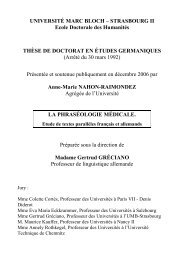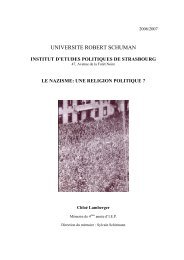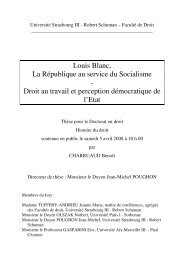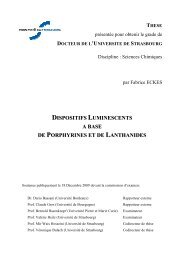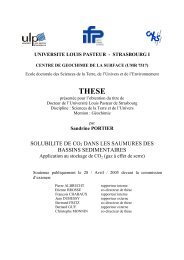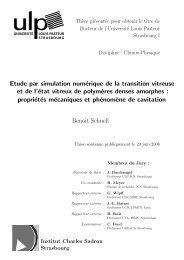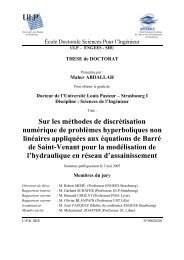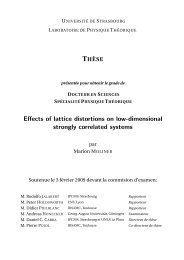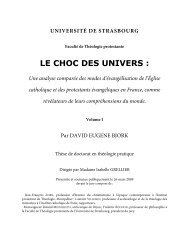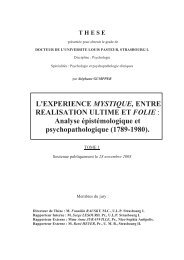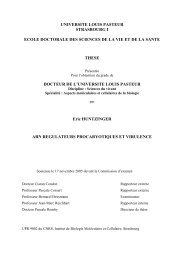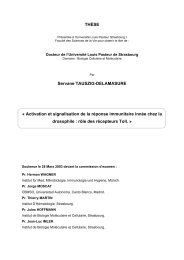Anthony KERMAGORET - THESES ET MEMOIRES DE L'UDS
Anthony KERMAGORET - THESES ET MEMOIRES DE L'UDS
Anthony KERMAGORET - THESES ET MEMOIRES DE L'UDS
Create successful ePaper yourself
Turn your PDF publications into a flip-book with our unique Google optimized e-Paper software.
Chapitre VI<br />
Noteworthy is the contrasting H-bonding behaviour of the P,O ligand in 13 and 14 which<br />
functions as both a donor and an acceptor in the former and acceptor in the latter. The Ni-O(1)<br />
bond of 13 should therefore be less perturbed by the H-bonding interaction involving O(2)<br />
than in 14, and the catalytic properties of the complex should remain similar to those of the<br />
SHOP-type catalyst 2.<br />
The reaction of ylids 8-10 with equimolar amounts of [Ni(COD)2] and PPh3 at room<br />
temperature only afforded the desired complexes 15-17 in low yield [eqn (4)].<br />
Ph<br />
O<br />
8-10<br />
PR 2R' + Ni(COD) 2 + PPh 3<br />
Ph<br />
R R'<br />
P<br />
O<br />
toluene<br />
Ni<br />
Ph<br />
PPh 3<br />
15 R = Ph, R' = t-Bu<br />
16 R = R' = n-Bu<br />
17 R=Ph,R'=n-Bu<br />
A significant fraction of the PPh3 reacted with the nickel precursor to form [Ni(PPh3)4], which<br />
gave rise in 31 P NMR spectroscopy to a broad peak around 26.1 ppm, and it was therefore not<br />
available to form the desired product. This led to only partial reaction and the low yield was<br />
evaluated by 1 H NMR monitoring of the chemical shifts of the C-H proton α to the<br />
phosphorus in the ligand and in the complex, or by evaluating unreacted [Ni(COD)2]. 38 In<br />
31 P{ 1 H} NMR spectroscopy, the two trans-coordinated phosphorus atoms of complexes 15-17<br />
form the expected AB pattern with 2 JPP coupling constants of 278, 280 and 282 Hz,<br />
respectively. All attempts made to isolate these nickel complexes led to increased<br />
decomposition. In the case of the β-keto phosphorus ylids 7 and 11, the formation of the<br />
complexes was not observed. Performing the complexation reactions at 60 °C with the hope<br />
to increase the yield resulted only in decomposition of [Ni(COD)2].<br />
To avoid the competition between the formation of [Ni(PPh3)4] and of the desired<br />
complexes by oxidative addition of the ylid, we used a pyridine ligand which is less<br />
nucleophilic than a phosphine. However, pyridine was not as reactive as PPh3 and a large<br />
excess had to be used. The reaction of the ylids 3 and 8-11 with one equiv. of [Ni(COD)2] and<br />
an excess of pyridine at room temperature led to the formation of the desired complexes 18-<br />
22, which have been characterised in 1 H and 31 P{ 1 H} NMR [eqn (5)].<br />
RT<br />
(4)<br />
9



